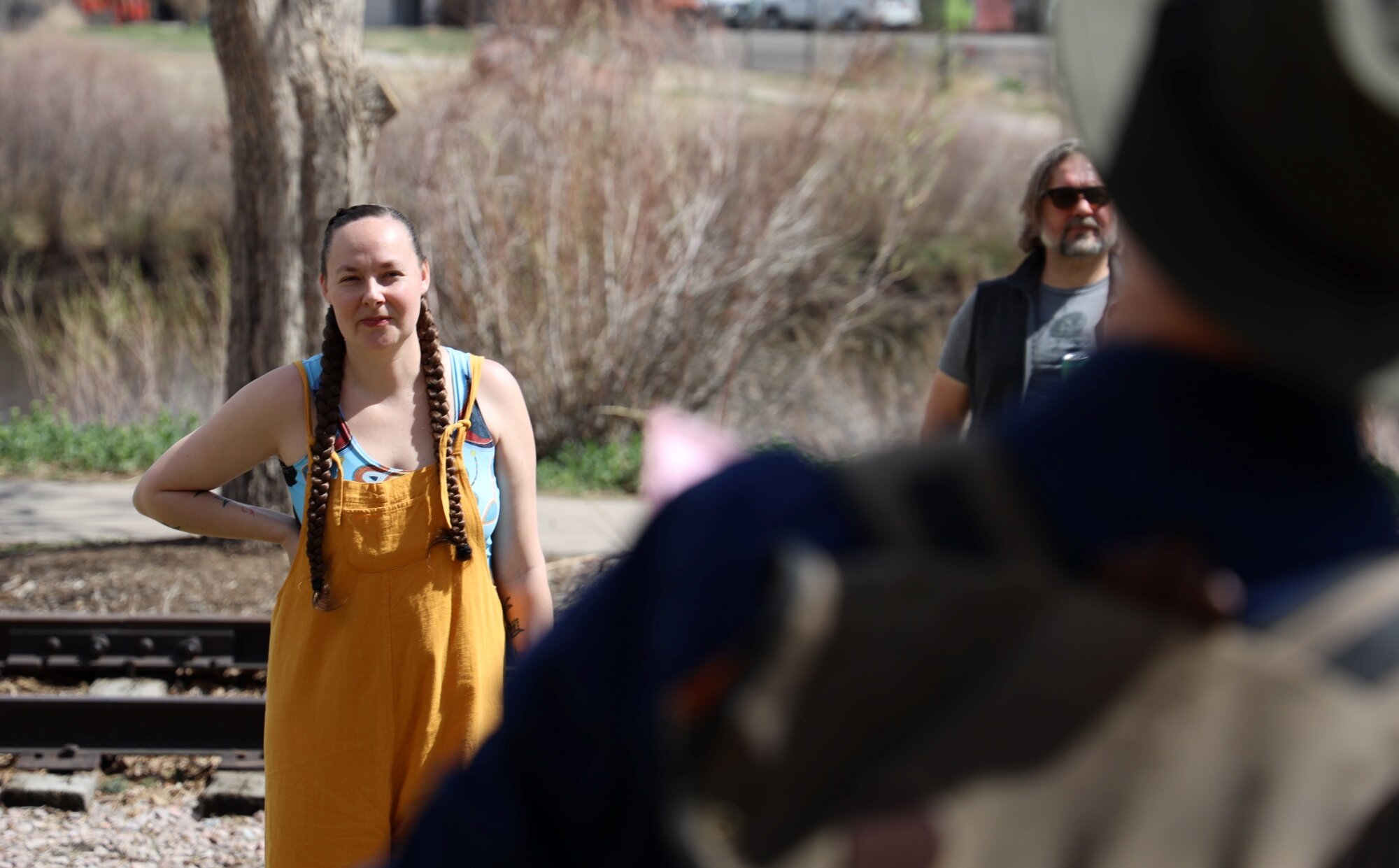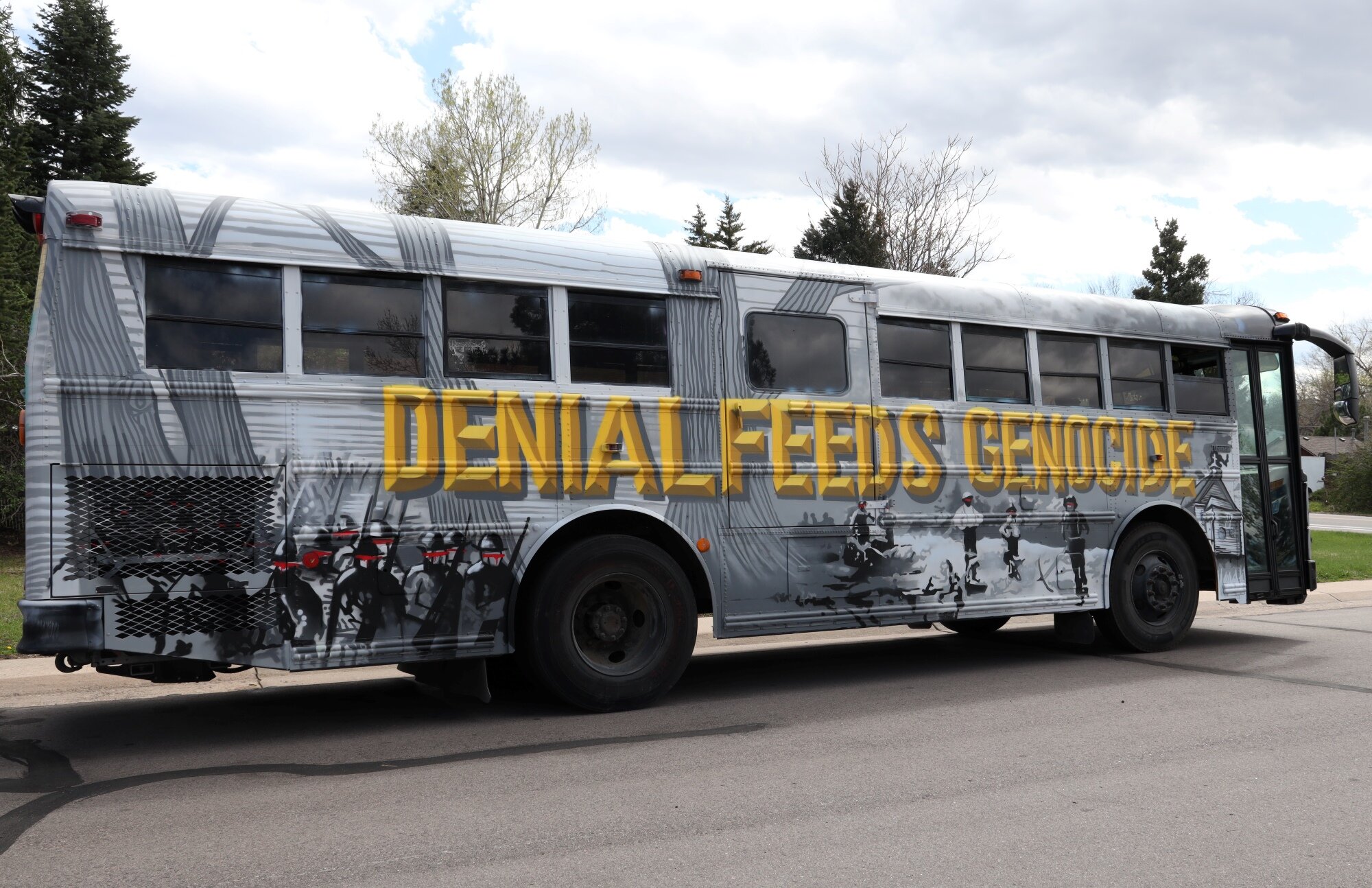Immersive theater production grapples with the history of the Sand Creek Massacre

DENVER — At Confluence Park in downtown Denver, where the South Platte River meets Cherry Creek, dogs splashed in the rushing water, skateboarders practiced tricks on the concrete steps and about a dozen people gathered to unpack the area’s brutal history through an interactive theater performance.
The performance, put on by local theater organization Control Group Productions, takes audience members to places around Denver connected to the city’s history of colonization, such as Confluence Park and the site of Camp Weld.
“We see this as an opportunity to bring people to some of the sites where this history is embedded and to engage them in an active interactive and participatory storytelling around that history so that we can then help heal from it,” said Patrick Mueller, director of Control Group Productions and co-lead of this latest production.
The park is regarded as Denver’s birthplace, where more than 165 years ago, prospectors — many of them white — set up a temporary camp in their search for gold.
Historically, the park and surrounding areas were a gathering place for the Cheyenne and Arapaho people, who gained — and never technically lost — sovereignty over the land in a treaty almost a decade prior to the prospectors’ settlement.
Tensions ran high as white settlers encroached on Native land. Even as some Cheyenne and Arapaho chiefs, along with a few settlers, advocated for peace, the Colorado military continued to brutalize Indigenous people. Most infamously in the 1864 Sand Creek Massacre, when Colorado soldiers ambushed and killed hundreds of peaceful Cheyenne and Arapaho people.
[Learn More: Colorado Experience: Sand Creek Massacre]
The park is also one of the sites included in an immersive theater production called “Breathing Healing into the Banks of Sand Creek.”
Cheyenne writer and activist Cinnamon Kills First is the production’s artistic director – and a descendant of survivors of the Sand Creek Massacre. Kills First lives and works in Washington but is staying in the Denver area to put on this production.
Kills First said this performance is geared toward non-Native audiences, who are not in the practice of working through the generational traumas left by historical injustices.
“What I understand of historical trauma is that it happens on both sides: the perpetrator side and the survivor side,” Kills First said. “This project is designed to help the descendants of the perpetrators face this history, to feel it in their body, to reckon with what happened here, so that they can create an emotional release in the body to open the door to healing.”

Cheyenne writer and activist Cinnamon Kills First believes historical trauma is stored in the body and designed “Breathing Healing” to help audiences process their emotions.
Photo: Amanda Horvath, Rocky Mountain PBS
Kills First is a proponent of somatic healing, which addresses emotional pain and trauma as a symptom of the body, not just the mind.
The production asks audience members to participate in the performance verbally and physically. In some scenes, the audience is encouraged to shout out responses to the performers’ prompts. In others, audience members encouraged to dance with the performers or handed props to hold.
Each scene and site covers a different chapter in the history surrounding the Sand Creek Massacre. As the performers reenact historical moments, the audience recreates both settler and Native roles.
One scene at Confluence Park asks audiences to embody some of the experiences that Indigenous people had when encountering white settlers: confusing language barriers, hostile treatment, reservation boundaries and children being stolen from their families.
Kills First said Native people in the audience would not be encouraged to participate in these scenes as they might be too traumatizing.
Audience members travel between performance sites on a specially painted school bus where they are encouraged to participate in guided meditations and breathing exercises. This is designed to be a soothing interlude between the difficult and emotional performances audiences grapple with at each site, Kills First said.
“We're tackling hard history and we're facing hard truths here, but we're also handling it with care,” Kills First said. “I think anyone who has a fear of guilt around this, anyone who is afraid to come, I would just extend the invitation that you're going to be cared for through this experience.”

Audience members will travel between performance sites on a bus painted by artist Diego Florez Arroyo. One side of the bus reads: Denial feeds genocide.
Photo: Carly Rose, Rocky Mountain PBS
The production’s opening show is May 2, but Mueller said the immersive nature of the performance called for a rehearsal with a test audience.
Nate Neufeld had previous experience with Mueller and Control Group Productions’ work, so he decided to participate as a test audience member for “Breathing Healing,” though he said he didn’t know what to expect from this production before the rehearsal.
Neufeld, now a Denver resident, moved to Colorado in the '80s and has lived in the state for most of his life. He said experiencing the performance in a historically significant geographical location made the message more powerful and personal.
“I definitely had some anxiety responses to different topics that can be very guarded and difficult for a lot of people to talk about, especially among strangers,” Neufeld said. “But I also think that being physically involved in the performance helps alleviate that a little bit and just process what's going on without setting up defensive reactions.”
"Breathing Healing” is not Control Group Productions’ first immersive theater piece. Mueller said he enjoys producing this style of performance because it sticks with the audience in a way that on-stage theater doesn’t. A performance on a stage can be left on the stage, he said.
“This type of artistic experience is not as easy to leave behind,” Mueller said. “It's embedded in your world, and it's embedded in you because you participated in it.”
Mueller and Kills First hope the staying power of immersive theater will encourage audiences to act after the performance to continue the healing process in their community.
At the end of the show, the company performers will hand out zines, or small pamphlets, to the audience that list direct actions they can take to support the Indigenous people whose land they live on.
“I think the main message I want people to come away with is understanding that no one's innocent,” Kills First said. “Colonization is still ongoing, which means each of us has a responsibility to do something about that.”
“Breathing Healing into the Banks of Sand Creek” runs from May 2-19 on Thursdays through Sundays. The show has three starting locations, depending on the date, in Englewood, Denver and Boulder.
In June, separate from the performance, Control Group Productions will offer bus trips for Indigenous peoples to the Sand Creek Massacre National Historic Site with storytelling and healing practices on the bus and at the site.
More information is available at controlgroupproductions.org.
Carly Rose is a multimedia journalist at Rocky Mountain PBS. Carlyrose@rmpbs.org.